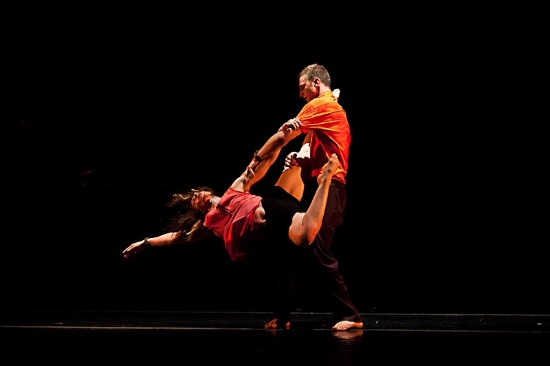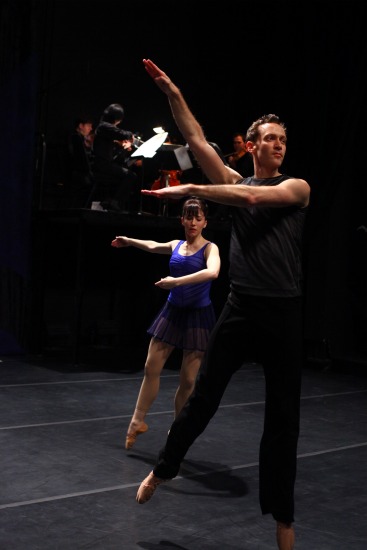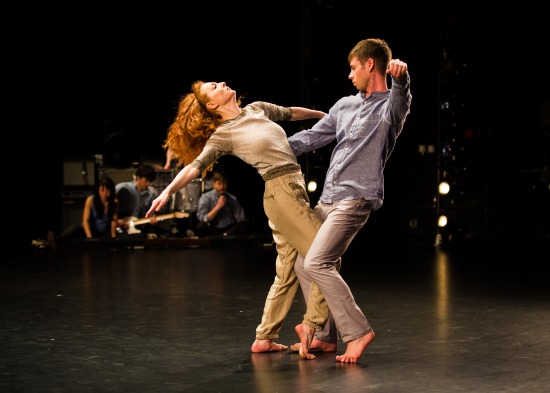
ChristinaNoel Reaves, Jessica Weiss, Lonnie Poupard, Jake Szczypek in Jody Oberfelder's Sung Heroes. Photo: Christopher Duggan
College basketball has nothing on the March Madness that seems to overtake the New York dance season just as spring is trying to inch in. I find myself momentarily mixing up dancers and works in my mind and trying to read notes scribbled on top of one another in a dense, black blob. Then there’s the pen that ran out of ink. . . .
Three performances have been running around in my mind on separate tracks—all by New York choreographers with very dissimilar styles and preoccupations: Jody Oberfelder, Pam Tanowitz, and Jodi Melnick.
Oberfelder has been choreographing longer than the other two women. Her works have been presented in an impressive number of theaters and festivals abroad. Her choreography is usually strongly designed (she received much of her training from Alwin Nikolais) and athletic (she was once a gymnast). Also, there’s something of the scallywag about her. For the March 1 through 3 performances by Jody Oberfelder Dance Projects at the Abrons Arts Center, she ventured into scientific territory. Reading in the program the science behind her new Throb and then watching the dance left me with a strange feeling of disorientation.
After much thought and conversations with a cardiologist, Oberfelder teamed up with sound designer Weston Minissali and composer Andy Akiho to make the heart activity involved in dancing both visible and audible. Five onstage musicians play the piano, violin, cello, marimba, and steel pan, while Minassali controls the electronic equipment. He and Oberfelder set up the atmosphere of a lab. ChristinaNoel Reaves and Lonnie Poupard walk over to him; he straps heart monitors around their ribcages and related instruments around their wrists. The principle seems to be that he feeds their heartbeats into the music in various ways. During their volatile, often drastic, occasionally touching dancing, they repeatedly thrust out their chests or bang on them to emphasize the process. Periodically, they stop to show Minissali their wrists. Once, he says to them: “surprise me!” (an echo, perhaps, of Serge Diaghilev’s long-ago command to Jean Cocteau: “étonne moi!”). They oblige. Poupard lifts Reaves and tosses her so that her breast slams against his; she gasps each time.
The set-up for Throb is much more complex than that of Sara Rudner’s 1998 Heartbeat:mb, a memorable solo in which Mikhail Baryshnikov danced with electrodes attached to his chest. No music, just the gripping sound of his heart speeding up, slowing down. I admire the courage, the gut-busting choreography, and the wit of Oberfelder’s experiment, but I have trouble identifying the heard heartbeats and how they effect the music. I can’t easily coordinate what I see with what I hear. Probably because of that, Throb feels cluttered, a lab-in-progress. The project will become more complex—and possibly more immediately accessible—when she expands it into a gallery performance-installation, Throb II, which will involve not only sound, dancing, and film, but “hands-on experiments” in which spectators’ heartbeats can alter what is seen and heard.
Oberfelder approaches the dancer as athlete differently in Sung Heroes, another premiere. Kathy Kaufmann’s lighting decks out the stage in bright-colored backdrops, night illumination, and shadows, while Poupard, Reaves, Jake Szczypek, and Jessica Weiss indulge in strenuous acrobatic play, with occasional displays of temperament, self-doubt, and individual triumphs. At one point, Weiss and Szczypek climb on platforms on either side of the proscenium and sing Muse’s “Time is Running Out” with the recorded score (The Section Quartet’s arrangements of songs by Led Zeppelin, David Bowie, et al). Reaves screams for no apparent reason and is comforted. Weiss gets thrown around like a rag doll by Szczypek. The winner? Reaves dances slowly and beautifully all alone onstage. These are fine, expressive dancers. I’m not sure what the overall trajectory of the piece is, although it’s always interesting to watch.
The program opened with Re:Dress, a solo by the choreographer, in which she tries out different effects with an imaginatively cut silk gown, occasionally saying things like, “Is this casual Friday?” She can be the temptress, but when she pulls the skirt over her head, she becomes a trudging peasant, before disappearing into the garment like Loïe Fuller, the fin-de-siècle transformation artist, turning herself into a lily. In the end, she removes the dress, folds it like a flag, and tosses it over her shoulder to a woman in underwear, who has appeared behind her. So goes fashion.
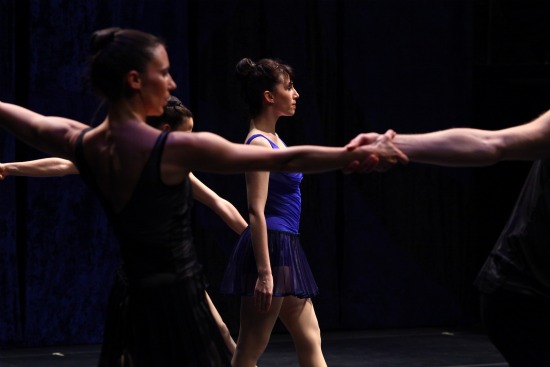
Ashley Tuttle in Pam Tanowitz's Untitled: The Blue Ballet (Jean Freebury, foreground). Photo: Paula Court
Pam Tanowitz’s style is less robust that Oberfelder’s. She’s in love with ballet and its precision, while shunning virtuosic display and presentational performing. She also credits the performers of Untitled: The Blue Ballet (the The Kitchen, March 8 through 12) with choreographic collaboration. They are an interestingly motley bunch: Jean Freebury was once a member of the Merce Cunningham Dance Company, John Heginbotham performs with the Mark Morris Dance Group, and Sasha Dmochowski, Brian Reeder, and Ashley Tuttle all danced with American Ballet Theatre at one time or another.
The performing, like the choreography, has a pleasing modesty and a clarity than amounts to reticence, but it’s sparked by unexpected pauses, coordinations, groupings, and repetitions. No one thrusts a leg up to 12 o’clock high, no one makes a pointed preparation to spin like a top. Reeder (an experienced choreographer himself) still has the proud chest of a premier danseur, but Tuttle—perhaps tempered by her work with Twyla Tharp—doesn’t present herself with any fanfare. Heginbotham, not a ballet dancer, has a touchingly unceremonious approach to partnering—approaching a woman with a friendly “need-some-help-there?” look. Freebury, softer in her attack than the others, has an engaging air of muted playfulness.
The choreography of Untitled (The Blue Ballet) suits the music (Morton Feldman’s String Quartet #1, performed live by the terrific FLUX Quartet) and inhabits the atmosphere it engenders, without clinging to it. As Alex Ross memorably wrote of Feldman in a 2006 New Yorker essay: “Harmonies hover in a no man’s land between consonance and dissonance, paradise and oblivion. Rhythms are irregular and overlapping, so that the music floats above the beat. Simple figures repeat for a long time, then disappear. There is no exposition or development of themes, no clear formal structure.” Much of that can be said of Tanowitz’s choreography, except that you do see structure and motifs do recur. The only problem with Untitled (The Blue Ballet) is that it loses steam during perhaps the last quarter of the very long piece of music and starts grinding its wheels. You can almost pinpoint when that happens by the minor restlessness that starts running through the audience (people here and there shifting in their seats, crossing and uncrossing their legs, people leaning on their elbows.
But up to that point, Untitled is a smart and lovely piece of work—understated, peaceful, a bit cool in tone, exacting in terms of craftsmanship and the accuracy of its performing. Tanowitz has interesting ways of adjusting an expected, essentially classical move until it becomes something else. As Tuttle lifts her arms high, she carefully hikes a shoulder, as if the gesture has to climb a hill. While dancing with Reeder, she slides into a split, and—with his help—travels, seated, over the floor by a process of opening and closing her legs. When you think she’s on her way to lifting one leg behind her in a ballet attitude with the appropriate port de bras, something happens in her back and the whole position arches, loosens and twists slightly. Standing in place, she does this over and over, and the more she does it the stranger and freer it looks—as if she were practicing to throw something, except that you can’t discern an aim.
Tuttle is the lynchpin around which the choreography turns. Karen Young has costumed her in blue, while the rest of the cast wear gray and black attire. Once onstage, she never leaves, as I remember, although she may, along with the others, briefly vanish behind two handsome hangings by Philip Treviño (in collaboration with Stephen Workman) made of textured, two-toned blue and bronze silk, with a curving design that travels across both of them (the lighting, too, is Treviño’s). At the end, the dancers come to rest under the tall upstage platform where the musicians sit, affirming that they swim in the not-quite-the-same-stream.
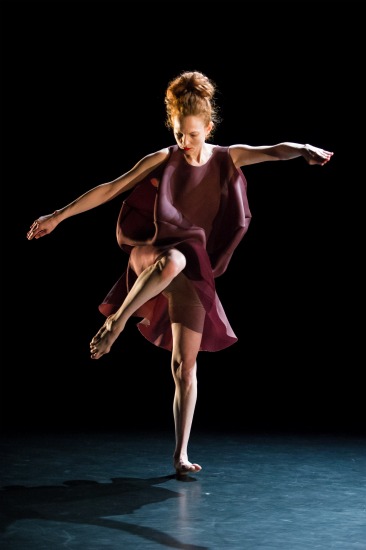
Jodi Melnick in One of Sixty Five Thousand Gestures (by Trisha Brown and Melnick). Photo: Ian Douglas
Jodi Melnick’s style is hard to pin down. The experience would be akin to standing in a stream while the fish you’re aiming to catch slip around you, flashing their silver scales. This is true, even in the new solo, One of Sixty Five Thousand Gestures, that Trisha Brown and she composed together. The gestures (hardly that many!) are both luminously clear and fluid. Melnick knows just how to finish one—say, lightly brushing her fingers over the floor—and, without blurring it, let the impulse for the next one slip into her body. Sometimes she holds a pose for a while, like one in which she clasps her hands behind her back and tilts her head to face the ceiling. But there always seems to be a current running through her.
Melnick looks beautiful in Yeohlee Tang’s intricately constructed plum-colored silk costume, whose top bells around her and sets off her red hair. The subtle modulations that she brings to every moment reveal her not just as a great dancer, but as a thoughtful one. No repetition is a clone of what came before. This collaborative work with Brown is not one that requires her to travel much, but in the atmosphere defined by Joe Levasseur’s white light and Hahn Rowe’s resonant, sometimes clamorous score, Melnick arranges the space like a visionary gardener who has only to direct a hand or a shoulder or a gaze in multiple directions to make flowers spring up.
Her own Solo, Deluxe Version is a quiet work and a calm one, but it has muscle. It also has four beguiling musicians—Steven Reker, Luke Fasano, Jem Goma, and James Rickman of the band People Get Ready (PGR)—who stand, sit, or crouch in a far corner, exchanging instruments and positions when necessary, watching the dancing intently all the time.
In this premiere, Melnick is joined by Hristoula Harakas, Jon Kinzel, and Stuart Shugg—all wearing casual clothes by JEM (subtly sparkly tops for the two women). While the musicians provide a variety of sounds and musical styles, the fours dancers investigate what seems like an ongoing stream of dancing. Someone walks in and catches a wave. Another person exits or breaks away, then returns. Almost always the movements seem a product of choice—a conversation that two may join in, whether it’s Melnick and Harakas doing the same paused moves against the back wall or Melnick suddenly jumping into Kinzel’s arms and, just as quickly, putting her feet on the floor again.
The dancing is grounded, but rarely heavy, the performers’ bodies softly buzzing hives of small activities. Impulses travel on circuitous paths through them, emerging in a rolling hip or shoulder, a pointing hand, a smoothly twisting head. Nothing seems out of control, yet hovers on the edge of risk. It’s hard to believe that 48 minutes have passed—we’ve spent it in such fascinating company.

